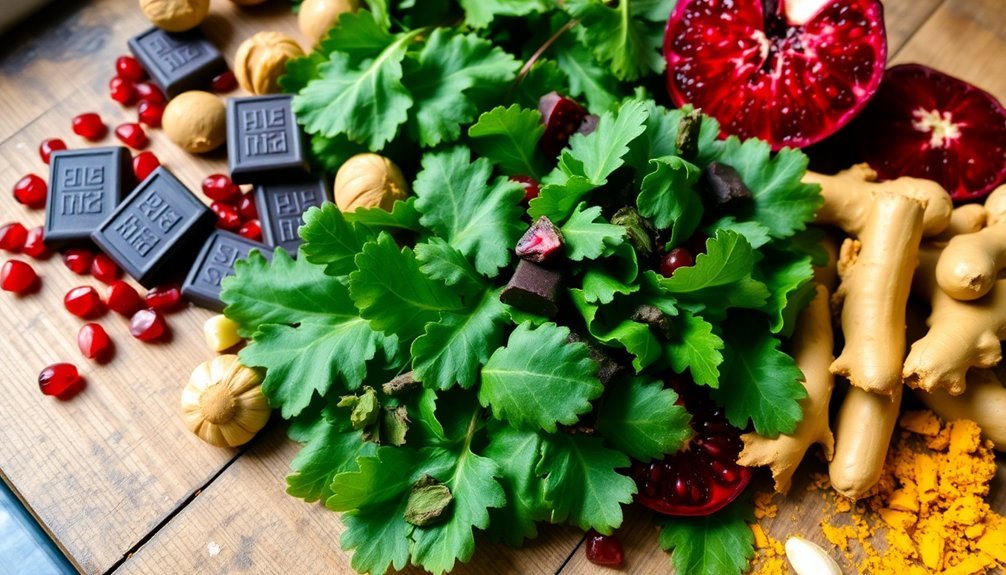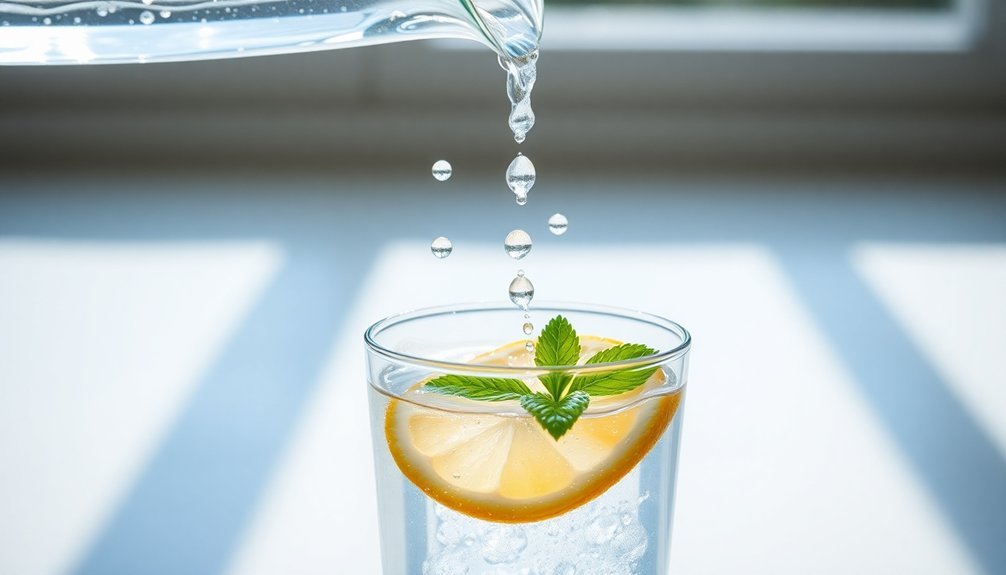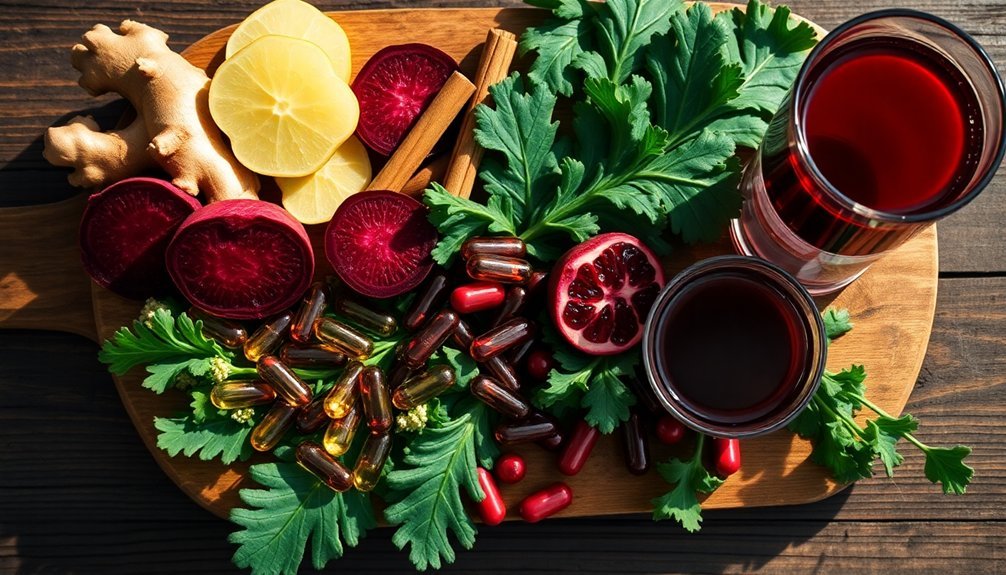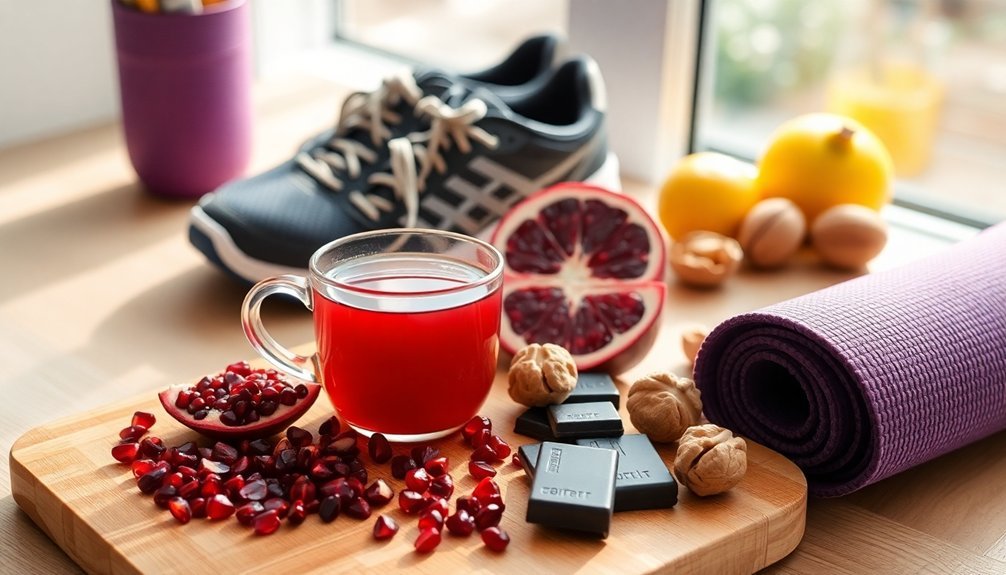You can naturally boost your blood flow starting today with these proven methods. Start by adding circulation-boosting foods like pomegranate juice, beets, and fatty fish to your meals. Get your body moving with simple activities like walking or stretching. Try alternating between hot and cold therapy to stimulate blood vessel response. Practice deep breathing exercises to enhance oxygen flow. Stay well-hydrated throughout the day, and consider red light therapy sessions for targeted circulation improvement. Natural supplements like L-arginine or beetroot powder can provide extra support. These seven strategies open the door to better energy, mental clarity, and overall health.
Eat For Better Blood Flow

Through a well-planned diet, you can naturally enhance your blood circulation and cardiovascular health. Start by incorporating pomegranate juice and fatty fish into your meals, as they're rich in antioxidants and omega-3 fatty acids that improve blood flow and reduce the risk of heart problems.
Add beets and leafy greens to your plate, as they contain nitrates that convert to nitric oxide, helping your blood circulate more efficiently. These greens are especially effective at thinning the blood and improving oxygen circulation throughout your body.
Don't forget to include circulation-boosting ingredients like garlic and onions, which widen your blood vessels and reduce blood pressure. Dark chocolate and berries provide flavonoids that relax blood vessels, while citrus fruits strengthen them through vitamin C.
You'll also benefit from adding nuts and seeds, particularly sunflower seeds and pumpkin seeds, which are packed with vitamin E and healthy fats that prevent blood clots.
For additional circulatory support, season your foods with powerful spices like turmeric, ginger, and cayenne pepper. These ingredients help reduce inflammation and strengthen your arteries.
You can also add avocados and olives to your diet, as their healthy fats and antioxidants support your cardiovascular system and improve overall circulation.
Move Your Body Daily
You don't need intense workouts to boost your blood flow – even light daily activities like walking, gentle stretching, or dancing can make a significant difference.
By moving your body for just 30 minutes each day, you'll help your blood vessels expand and become more flexible, increasing blood flow by up to 25%.
Regular movement reduces arterial stiffness and promotes long-term vascular health.
Simple stretching exercises can further enhance circulation by loosening tight muscles and promoting better blood flow throughout your body.
Light Exercise Each Day
Moving your body through light exercise each day delivers powerful benefits for blood circulation and overall health. When you replace just 30 minutes of sitting with light activity, you can lower your mortality risk by 14%. Light exercise keeps your arteries flexible and promotes efficient blood flow throughout your body.
| Activity Type | Circulation Benefits |
|---|---|
| Daily Walking | Improves cardiovascular fitness and reduces heart disease risk |
| House Chores | Stimulates blood flow through natural movement patterns |
| Stair Climbing | Enhances overall circulation and artery health |
You don't need intense workouts to see improvements. Simple activities like walking slowly, doing light housework, or playing recreational games like croquet can make a significant difference. Try getting off the bus one stop earlier, taking walking meetings, or using the stairs instead of the elevator. Make these activities part of your daily routine by incorporating them during work, leisure time, and home activities. The key is consistency – even small amounts of movement, when done regularly, can lead to lasting cardiovascular benefits and improved blood flow throughout your body. These activities are especially beneficial since research shows that light physical activity helps reduce the risk of certain cancers and heart disease.
Stretching For Better Flow
Tight muscles can restrict blood flow like a kinked garden hose, making daily stretching essential for maintaining healthy circulation.
When you stretch, your muscles press against arteries, triggering the release of chemicals that expand blood vessels and enhance blood flow throughout your body. This increased circulation delivers crucial oxygen and nutrients to your muscles and organs while reducing inflammation. The parasympathetic nervous system activates during stretching, helping your body relax and reduce stress levels.
You'll get the best results by incorporating both static and dynamic stretches into your routine. Try walking lunges to warm up your lower body, followed by arm circles to improve upper body circulation. The downward dog pose stretches your entire body, while legs-up-the-wall helps reduce leg stiffness and promotes blood flow in your lower extremities.
To stretch safely, start with a brief warm-up like walking or marching in place. Hold each stretch for 15-30 seconds, breathing deeply and sinking further into the position with each exhale. Don't push beyond gentle tension, as overstretching can cause injury.
If you can't perform regular exercise, stretching offers an excellent alternative for maintaining cardiovascular health and reducing your risk of heart disease.
Cold And Heat Therapy

Alternating between cold and hot therapy can boost your blood flow and give tired muscles a natural boost.
You'll want to start with a warm application to dilate your blood vessels, then switch to cold therapy to cause constriction, and finally return to heat – creating a pumping effect that enhances circulation.
This contrast therapy works especially well after intense workouts, when your muscles need help with recovery and blood flow improvement.
Alternating Hot-Cold Treatment
Through the strategic use of hot and cold treatments, you can substantially enhance your blood circulation while promoting faster recovery from injuries and muscle soreness. This method, known as contrast therapy, works by creating a pumping action in your blood vessels as they alternately expand and contract.
When you apply heat, your blood vessels dilate, increasing blood flow and oxygen delivery to tissues while relaxing your muscles. Conversely, cold therapy causes your blood vessels to constrict, reducing inflammation and numbing pain.
This alternating process stimulates your lymphatic system, helping remove metabolic waste products from your body.
You'll find contrast therapy particularly effective for exercise-induced muscle soreness and musculoskeletal injuries. For ideal results, protect your skin by never applying ice directly to it, and limit cold therapy sessions to 15-20 minutes.
If you have high blood pressure or heart disease, consult your doctor before starting this treatment.
For acute injuries, start with cold therapy to reduce inflammation. For chronic pain, begin with heat to promote blood flow. You'll maximize benefits by using appropriate temperature levels and maintaining proper time intervals between hot and cold applications.
Benefits For Tired Muscles
After an intense workout, both cold and heat therapy offer powerful solutions for your tired, aching muscles. Cold therapy works by constricting blood vessels and reducing blood flow, which effectively decreases inflammation, swelling, and pain sensitivity.
Heat therapy, on the other hand, increases blood flow and circulation, relaxing your muscles and boosting metabolism to aid healing.
You'll find both treatments effective, but they serve different purposes. Cold therapy excels at immediate pain relief and works particularly well for delayed onset muscle soreness (DOMS).
Heat therapy proves superior for strength recovery and preventing elastic tissue damage right after exercise.
Here's when to use each therapy for the best results:
- Apply cold therapy immediately post-exercise or 24 hours later to reduce pain and inflammation
- Use heat therapy when you need to improve circulation and boost nutrient flow to injured tissues
- Try cold water immersion for better long-term recovery compared to passive rest
- Choose heat treatment when your priority is maintaining strength and preventing tissue damage
Whether you opt for cold or heat therapy, you'll experience less strength loss compared to no treatment at all, making both valuable tools in your recovery arsenal.
Master Your Breathing Techniques
By mastering proper breathing techniques, you'll activate one of the most powerful natural ways to boost your blood circulation. Deep, controlled breathing enhances blood flow by promoting nitric oxide production in your endothelial cells while activating your parasympathetic nervous system.
Start with diaphragmatic breathing by placing one hand on your chest and another below your rib cage. Keep your chest still while breathing deeply from your belly.
You can also practice pursed lip breathing by inhaling through your nose and exhaling slowly through pursed lips, making your exhale twice as long as your inhale.
For structured practice, try box breathing: inhale for 4 counts, hold for 4, exhale for 4, and hold for 4. This technique helps decrease your heart rate and promotes relaxation.
High-resistance inspiratory muscle strength training (IMST) can increase your endothelial function by up to 45% and lower systolic blood pressure by about 9 mmHg after six weeks of consistent practice.
When dealing with a racing heart, focus on deep abdominal breathing or try the counted breath technique: inhale for 4, hold for 7, and exhale for 8.
Stay Hydrated For Circulation

Just as proper breathing energizes your body, staying well-hydrated keeps your blood flowing smoothly throughout your system. Since blood is about 90% water, dehydration can substantially impact your circulation by reducing blood volume and forcing your heart to work harder than necessary.
You'll know you're becoming dehydrated when you notice these key symptoms:
- Dark yellow urine and reduced urination frequency
- Dizziness, lightheadedness, or unexplained fatigue
- Dry mouth, lips, and tongue
- Increased heart rate and potential blood pressure changes
To maintain proper hydration and support healthy circulation, monitor your water intake throughout the day. If you're exercising or in hot weather, you'll need to drink more – about a pint of water for every pound of sweat lost.
While you might be tempted to reach for caffeinated or sugary drinks, these can actually worsen dehydration. Instead, focus on pure water and incorporate hydrating foods like fruits and vegetables into your diet.
Targeted Light Therapy Sessions
Looking for a modern approach to boost circulation? Targeted light therapy sessions using specific wavelengths of red light can substantially enhance your blood flow and promote healing throughout your body.
When red light penetrates your skin, it stimulates your cells to produce more nitric oxide, which naturally widens your blood vessels and improves circulation.
You'll find that regular light therapy sessions, lasting 10-20 minutes about 3-5 times weekly, can make a real difference in your circulation. The treatment works particularly well for conditions like peripheral artery disease, diabetic neuropathy, and chronic venous insufficiency.
Athletes also use this therapy to speed up muscle recovery and enhance performance.
To get started, you can choose between professional treatments or at-home devices. While professional sessions offer deeper penetration and expert guidance, quality home devices can still provide substantial benefits.
Focus the light on areas where you're experiencing poor circulation, such as your legs, feet, or hands. For best results, combine light therapy with other healthy practices like regular exercise and proper nutrition.
You'll notice improved healing, reduced inflammation, and better overall circulation with consistent use.
Natural Supplements For Circulation

Natural supplements offer a powerful way to enhance your circulation without relying on prescription medications. Your body's blood flow can substantially improve when you incorporate specific vitamins, minerals, and herbs into your daily routine.
- Amino acids like L-arginine and natural compounds found in beetroot powder work together to boost nitric oxide production, helping your blood vessels dilate and improve circulation.
- Essential vitamins E and C protect your blood vessels while preventing platelet stickiness, with vitamin B3 reducing inflammation and cholesterol levels.
- Herbal supplements like turmeric, ginger, and garlic contain active compounds that naturally dilate your blood vessels and reduce inflammation.
- Omega-3 fatty acids and pomegranate juice provide powerful anti-inflammatory benefits that keep your blood flowing smoothly.
You'll find that many of these supplements work synergistically to enhance their effectiveness. For example, combining vitamin C with turmeric can amplify their anti-inflammatory properties, while pairing L-arginine with beetroot powder can maximize nitric oxide production.
When selecting supplements, look for high-quality products and consider starting with one or two before gradually expanding your regimen.
Frequently Asked Questions
Can Certain Medications Negatively Affect Blood Circulation?
Yes, your medications can harm circulation. Cancer drugs, beta-blockers, antidepressants, and immunosuppressants may cause vasoconstriction, leading to poor blood flow and increased blood pressure. Always consult your doctor about concerns.
How Quickly Can Lifestyle Changes Improve Blood Flow?
You'll notice improvements in blood flow within minutes through hydration and movement, within days through exercise and stress reduction, and within weeks through dietary changes and consistent physical activity patterns.
Do Compression Socks Work While Sleeping?
You shouldn't wear compression socks while sleeping unless your doctor specifically recommends it. They're most effective when you're upright and active, as lying down reduces gravity's effects on blood circulation.
Is Poor Circulation Hereditary?
Yes, poor circulation can be hereditary. You're more likely to develop circulatory issues if your parents had them. Your risk doubles with family history, and genetic factors can affect blood vessels and clotting.
Can Weather Changes Affect Blood Circulation Patterns?
Yes, weather changes substantially affect your circulation. When it's cold, your blood vessels constrict, reducing blood flow. Hot weather causes vessels to dilate, while temperature fluctuations can strain your cardiovascular system.
In Summary
You've got plenty of natural options to boost your circulation starting today. Whether you're focusing on nutrition, movement, or temperature therapy, consistency is key. Make these blood flow-boosting habits part of your daily routine, and you'll likely notice improved energy, better recovery, and enhanced overall wellness. Remember, small changes in how you eat, move, and breathe can create significant improvements in your circulation.





Leave a Reply